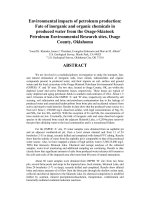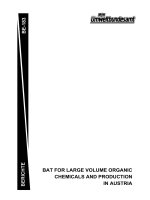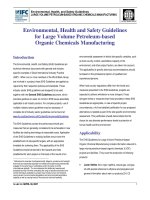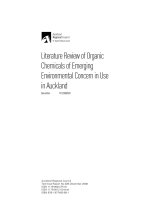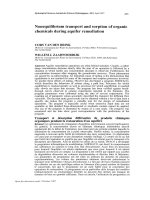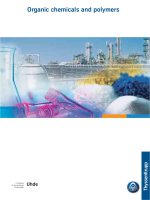industrial organic chemicals 2nd edition
Bạn đang xem bản rút gọn của tài liệu. Xem và tải ngay bản đầy đủ của tài liệu tại đây (4.53 MB, 687 trang )
INDUSTRIAL ORGANIC
CHEMICALS
ffirs.qxd 29.5.04 11:13 Page i
INDUSTRIAL ORGANIC
CHEMICALS
Second Edition
HAROLD A. WITTCOFF
Scientific Adviser, Nexant ChemSystems Inc.; Vice President of Corporate
Research, General Mills, Inc. (ret.)
BRYAN G. REUBEN
Professor Emeritus of Chemical Technology
London South Bank University
JEFFREY S. PLOTKIN
Director, Process Evaluation and Research Planning Program,
Nexant ChemSystems Inc.
A John Wile
y
& Sons, Inc., Publication
ffirs.qxd 29.5.04 11:13 Page iii
Copyright © 2004 by John Wiley & Sons, Inc. All rights reserved.
Published by John Wiley & Sons, Inc., Hoboken, New Jersey.
Published simultaneously in Canada.
No part of this publication may be reproduced, stored in a retrieval system, or transmitted in any form
or by any means, electronic, mechanical, photocopying, recording, scanning, or otherwise, except as
permitted under Section 107 or 108 of the 1976 United States Copyright Act, without either the prior
written permission of the Publisher, or authorization through payment of the appropriate per-copy fee to
the Copyright Clearance Center, Inc., 222 Rosewood Drive, Danvers, MA 01923, 978-750-8400, fax
978-646-8600, or on the web at www.copyright.com. Requests to the Publisher for permission should
be addressed to the Permissions Department, John Wiley & Sons, Inc., 111 River Street, Hoboken,
NJ 07030, (201) 748-6011, fax (201) 748-6008.
Limit of Liability/Disclaimer of Warranty: While the publisher and author have used their best efforts
in preparing this book, they make no representations or warranties with respect to the accuracy or
completeness of the contents of this book and specifically disclaim any implied warranties of
merchantability or fitness for a particular purpose. No warranty may be created or extended by sales
representatives or written sales materials. The advice and strategies contained herein may not be
suitable for your situation. You should consult with a professional where appropriate. Neither the
publisher nor author shall be liable for any loss of profit or any other commercial damages, including
but not limited to special, incidental, consequential, or other damages.
For general information on our other products and services please contact our Customer Care
Department within the U.S. at 877-762-2974, outside the U.S. at 317-572-3993 or fax 317-572-4002.
Wiley also publishes its books in a variety of electronic formats. Some content that appears in print,
however, may not be available in electronic format.
Library of Congress Cataloging-in-Publication Data:
Wittcoff, Harold.
Industrial organic chemicals.—2nd ed. / Harold A. Wittcoff, Bryan G. Reuben, Jeffrey S. Plotkin.
p. cm.
Includes index.
ISBN 0-471-44385-9 (Cloth)
1. Organic compounds—Industrial applications. I. Reuben, B. G. II. Plotkin, Jeffrey S. III. Title.
TP247.W59 2004
661.8—dc22 2003023097
Printed in the United States of America
10987654321
ffirs.qxd 29.5.04 11:13 Page iv
OTHER BOOKS BY THE AUTHORS
The Phosphatides, by Harold A. Wittcoff, Reinhold, New York, 1950.
The Chemical Economy, by Bryan G. Reuben and Michael L. Burstall, Longman,
London, 1973.
Industrial Organic Chemicals in Perspective, Part 1: Raw Materials and Manu-
facture, Part 2: Technology, Formulation, and Use, by Harold A. Wittcoff and
Bryan G. Reuben, Wiley, New York, 1980.
Industrial Organic Chemistry, an ACS tape course, by Harold A. Wittcoff, ACS,
Washington DC, 1984.
The Pharmaceutical Industry—Chemistry and Concepts, an ACS tape course, by
Harold A. Wittcoff and Bryan G. Reuben, ACS, Washington DC, 1987.
The Cost of “Non-Europe” in the Pharmaceutical Industry, Research in the Cost
of “Non-Europe,” Basic Findings Vol. 15, by Michael L. Burstall and Bryan G.
Reuben, Commission of European Communities, Luxembourg, 1988.
Pharmaceutical Chemicals in Perspective, by Bryan G. Reuben and Harold A.
Wittcoff, Wiley, New York, 1990.
Cost Containment in the European Pharmaceutical Market, by Michael L.
Burstall and Bryan G. Reuben, Marketletter, London, 1992.
Implications of the European Community’s Proposed Policy for Self-Sufficiency
in Plasma and Plasma Products, by Bryan G. Reuben and Ian Senior,
Marketletter, London, 1993.
Outlook for the World Pharmaceutical Industry to 2010, by M. L. Burstall and
B. G. Reuben, Decision Resources, Waltham MA, 1999.
Organic Chemical Principles and Industrial Practice by M. M. Green and
Harold A. Wittcoff, VCH Wiley, Weinheim, Germany, 2003.
Outlook for the World Pharmaceutical Industry to 2015, by M. L. Burstall and
B. G. Reuben, Decision Resources, Waltham MA, 2004.
ffirs.qxd 29.5.04 11:13 Page v
To our wives, Dorothy, Catherine, and Marisa, and to our children,
grandchildren, and great-grandchildren.
ffirs.qxd 29.5.04 11:13 Page vii
ACKNOWLEDGMENTS
We gratefully acknowledge the help of Professor Maurice Kreevoy, who reviewed
the chapter on catalysis and offered many helpful suggestions. Mrs. Denise Phillips
searched the literature diligently for us. We thank Ms. Carol Conti of Nexant
ChemSystems Inc. for many insights about the supply and demand situation for
many of the large volume petrochemicals and plastics. We are particularly grateful
to Nexant ChemSystems Inc., whose numerous multiclient reports provided detailed
information about reaction conditions and production economics. And we are grate-
ful to our wives, who gave us encouragement at all stages of this enterprise.
ffirs.qxd 29.5.04 11:13 Page ix
xi
CONTENTS
PREFACE xxiii
PREFACE TO THE FIRST EDITION xxv
LIST OF ACRONYMS AND ABBREVIATIONS xxvii
CHAPTER 0 HOW TO USE INDUSTRIAL ORGANIC CHEMICALS,
SECOND EDITION 1
0.1 Why this Book was Written and
how it is Structured / 1
0.2 North American Industry Classification / 3
0.3 Units and Nomenclature / 4
0.4 General Bibliography / 4
0.4.1 Encyclopedias / 5
0.4.2 Books / 6
0.4.3 Journals / 9
0.4.4 Patents / 9
0.4.5 Statistics / 11
0.4.6 CD-ROM and On-Line Databases / 12
CHAPTER 1 THE CHEMICAL INDUSTRY 15
1.1 The National Economy / 15
1.2 Size of the Chemical Industry / 20
ftoc.qxd 29.5.04 11:15 Page xi
1.3 Characteristics of the Chemical Industry / 21
1.3.1 Maturity / 21
1.3.1.1 Realignment of Business Segments / 26
1.3.2 Participation in International Trade / 28
1.3.3 Competition from Developing Countries / 29
1.3.4 Capital Intensity and Economies of Scale / 32
1.3.5 Criticality and Pervasiveness / 33
1.3.6 Freedom of Market Entry / 35
1.3.7 Strong Health and Safety Regulation / 36
1.3.8 High Research and Development Expenditures / 41
1.3.9 Dislocations / 46
1.4 The Top Chemical Companies / 48
1.5 The Top Chemicals / 50
Notes and References / 53
CHAPTER 2 CHEMICALS FROM NATURAL GAS AND
PETROLEUM 57
2.1 Petroleum Distillation / 61
2.2 Petroleum Refining Reactions / 67
2.2.1 Steam Cracking / 67
2.2.1.1 Choice of Feedstock / 70
2.2.1.2 Economics of Steam Cracking / 71
2.2.1.3 Mechanism of Cracking / 76
2.2.2 Catalytic Cracking / 76
2.2.3 Catalytic Reforming / 79
2.2.4 Oligomerization / 82
2.2.5 Alkylation / 84
2.2.6 Hydrotreating and Coking / 84
2.2.7 Dehydrogenation / 86
2.2.8 Isomerization / 87
2.2.9 Metathesis / 87
2.2.9.1 Metathesis Outside the Refinery / 89
2.2.9.2 Mechanism of Metathesis / 90
2.3 The Refinery—A Perspective / 92
2.3.1 The Function of the Refinery and the Potential
Petroleum Shortage / 92
2.3.2 Unleaded Gasoline and the Clean Air Act / 93
2.4 Separation of Natural Gas / 96
Notes and References / 96
xii CONTENTS
ftoc.qxd 29.5.04 11:15 Page xii
CHAPTER 3 CHEMICALS AND POLYMERS FROM ETHYLENE 100
3.1 Ethylene Polymers / 105
3.1.1 Discovery of Low- and High-Density
Polyethylenes / 105
3.1.2 Low-Density Polyethylene / 106
3.1.3 High-Density Polyethylene / 107
3.1.4 Linear Low-Density Polyethylene / 108
3.1.5 Very High Molecular Weight Polyethylene / 109
3.2 Ethylene Copolymers / 109
3.2.1 Chlorosulfonated Polyethylene / 109
3.2.2 Ethylene-Vinyl Acetate / 110
3.2.3 Ionomers / 111
3.2.4 Copolymer from “Incompatible” Polymer
Blends / 111
3.2.5 Ethylene–Propylene Elastomers / 111
3.2.6 Ultra-Low-Density Polyethylene / 112
3.2.7 Photodegradable Copolymers / 112
3.3 Oligomerization / 113
3.3.1 Dimerization / 113
3.3.2 Ziegler Oligomerization of Ethylene / 114
3.3.3 Other Ethylene Oligomerization Technologies / 115
3.3.4 The Shell Higher Olefins Process (SHOP) / 116
3.4 Vinyl Chloride / 119
3.5 Acetaldehyde / 121
3.6 Vinyl Acetate / 124
3.7 Ethylene Oxide / 126
3.7.1 Ethylene Glycol / 127
3.7.2 Proposed Non-Ethylene Oxide Processes
for Ethylene Glycol Production / 129
3.8 Styrene / 132
3.9 Ethanol / 135
3.10 Major Chemicals from Ethylene—A Summary / 137
3.11 Lesser Volume Chemicals from Ethylene / 139
3.11.1 Hydroformylation—Propionaldehyde, Propionic
Acid, and n-Propanol / 140
3.11.2 Ethyl Halides / 141
3.11.3 Acetaldehyde Chemistry / 142
3.11.4 Metal Complexes / 146
3.11.5 Ethylenediamine and Related Compounds / 147
CONTENTS xiii
ftoc.qxd 29.5.04 11:15 Page xiii
3.11.6 Ethylene Oxide and Ethylene Glycol
Derivatives / 149
3.11.6.1 Oligomers / 149
3.11.6.2 Glycol Ethers and Esters / 149
3.11.6.3 Ethylene Carbonate / 150
3.11.6.4 Aminoethyl Alcohols (Ethanolamines)
and Derivatives / 153
3.11.6.5 Ethylenimine / 154
3.11.6.6 1,3-Propanediol / 155
3.11.6.7 Ethylene Glycol Derivatives / 156
3.11.7 Vinyl Chloride and Ethylene Dichloride
Derivatives / 158
3.11.8 Vinyl Fluoride and Vinylidene Fluoride / 159
3.11.9 Ethylene Dibromide / 160
3.11.10 Ethanol Derivatives / 161
3.11.11 Vinyl Esters and Ethers / 162
Notes and References / 163
CHAPTER 4 CHEMICALS AND POLYMERS FROM PROPYLENE 167
4.1 On-Purpose Propylene Production Technologies and
Propane Dehydrogenation / 168
4.2 Propylene via Deep Catalytic Cracking / 169
4.3 Propylene via Olefin Metathesis / 169
4.4 Propylene via Selective C
4
/C
5
Cracking / 171
4.5 Main Polymers and Chemicals from Propylene / 172
4.5.1 Propylene Polymers and Copolymers / 172
4.6 Oligomerization / 175
4.7 Acrylic Acid / 176
4.8 Acrylonitrile / 181
4.8.1 Uses of Acrylonitrile / 183
4.9 Cumene, Cumene Hydroperoxide, and Phenol / 184
4.10 Acetone and Isopropanol / 187
4.10.1 Methyl Methacrylate / 188
4.10.2 Methyl Isobutyl Ketone and other Acetone
Derivatives / 193
4.11 Propylene Oxide / 195
4.11.1 Propylene Oxide Applications / 198
4.11.2 Projected Propylene Oxide–Propylene Glycol
Processes / 199
xiv CONTENTS
ftoc.qxd 29.5.04 11:15 Page xiv
4.11.3 Other Novel Syntheses of Propylene Oxide / 200
4.11.3.1 Direct Oxidation / 200
4.11.3.2 Use of Peracids or Hydrogen
Peroxide / 201
4.11.3.3 Electrochemical Processes / 202
4.11.3.4 Biotechnological Approaches / 204
4.12 n-Butyraldehyde and Isobutyraldehyde / 205
4.12.1 Uses for Butyraldehyde and Isobutyraldehyde / 207
4.12.2 Other Oxo Products / 208
4.13 Major Chemicals from Propylene—A Perspective / 209
4.14 Lesser Volume Chemicals from Propylene / 211
4.14.1 Allyl Chloride and Epichlorohydrin / 211
4.14.2 Glycerol / 214
4.14.3 Acrylamide / 215
4.14.4 Acrolein / 216
4.14.5 Acrylonitrile Derivatives / 218
Notes and References / 218
CHAPTER 5 CHEMICALS AND POLYMERS FROM THE C
4
STREAM 223
5.1 Chemicals and Polymers from Butadiene / 226
5.1.1 Acrylonitrile–Butadiene–Styrene
Resins (ABS) / 230
5.1.2 Hexamethylenediamine / 231
5.1.3 Lesser Volume Chemicals from Butadiene / 236
5.1.3.1 Cyclization / 236
5.1.3.2 Dimerization and Trimerization / 237
5.1.3.3 Diels–Alder Reactions / 239
5.1.3.4 Adipic Acid / 240
5.1.3.5 1,4-Butanediol / 241
5.1.3.6 trans-1,4-Hexadiene / 241
5.1.3.7 Dimethyl-2,6-naphthalene
Dicarboxylate / 241
5.1.3.8 Butadiene Monoepoxide / 241
5.2 Chemicals and Polymers from Isobutene / 242
5.2.1 Methyl tert-butyl Ether / 243
5.2.2 Butyl Rubber / 244
5.2.3 Polyisobutenes and Isobutene Oligomers and
Polymers / 244
CONTENTS xv
ftoc.qxd 29.5.04 11:15 Page xv
5.2.4 tert-Butanol / 245
5.2.5 Methyl Methacrylate / 245
5.2.6 Lesser Volume Chemicals from Isobutene / 245
5.3 Chemicals and Polymers from 1- and 2-Butenes / 248
5.4 Chemicals from n-Butane / 249
5.4.1 Acetic Acid / 249
5.4.2 Maleic Anhydride / 249
Notes and References / 251
CHAPTER 6 CHEMICALS AND POLYMERS FROM THE C
5
STREAM 255
6.1 Separation of the C
5
Stream / 256
6.2 Isoprene / 259
6.3 Cyclopentadiene and Dicyclopentadiene / 263
6.4 Pentene-1 and Piperylene / 265
Notes and References / 266
CHAPTER 7 CHEMICALS AND POLYMERS FROM BENZENE 267
7.1 Phenol / 269
7.1.1 Phenolic Resins / 275
7.1.2 Bisphenol A / 276
7.1.2.1 Epoxy Resins / 277
7.1.2.2 Polycarbonate Resins / 277
7.1.2.3 Lesser Volume Uses for
Bisphenol A / 280
7.1.3 Cyclohexanone / 281
7.1.4 Alkylphenols / 283
7.1.5 Chlorinated Phenols / 283
7.1.6 2,6-Xylenol and Cresols / 284
7.1.7 Aniline from Phenol / 284
7.2 Cyclohexane / 285
7.2.1 Adipic Acid / 285
7.2.1.1 Nylons from Adipic Acid / 289
7.2.2 Caprolactam / 290
7.3 Aniline / 294
7.3.1 4,4Ј-Diphenylmethane Diisocyanate (MDI) / 296
7.4 Alkylbenzenes / 299
7.5 Maleic Anhydride / 301
7.6 Chlorinated Benzenes / 301
xvi CONTENTS
ftoc.qxd 29.5.04 11:15 Page xvi
7.7 Dihydroxybenzenes / 302
7.8 Anthraquinone / 308
Notes and References / 309
CHAPTER 8 CHEMICALS AND POLYMERS FROM TOLUENE 312
8.1 Hydrodealkylation and Disproportionation / 313
8.2 Solvents / 314
8.3 Dinitrotoluene and Toluene Diisocyanate / 314
8.4 Lesser Volume Chemicals from Toluene / 316
Notes and References / 318
CHAPTER 9 CHEMICALS AND POLYMERS FROM XYLENES 320
9.1 o-Xylene and Phthalic Anhydride / 322
9.1.1 Uses of Phthalic Anhydride / 323
9.2 m-Xylene and Isophthalic Acid / 327
9.2.1 Uses of Isophthalic Acid / 328
9.3 p-Xylene and Terephthalic Acid—Dimethyl
Terephthalate / 329
9.3.1 Oxidation of p-Xylene / 329
9.3.2 Alternate Sources for Terephthalic Acid / 331
9.3.3 Poly(ethylene terephthalate) / 332
9.3.4 Lower Volume Polymers from Terephthalic
Acid / 334
9.4 Major Chemicals from Xylenes: A Summary / 335
Notes and References / 336
CHAPTER 10 CHEMICALS FROM METHANE 338
10.1 Hydrocyanic Acid / 338
10.2 Halogenated Methanes / 341
10.2.1 Chloromethane / 342
10.2.2 Dichloromethane / 343
10.2.3 Trichloromethane / 343
10.2.4 Tetrachloromethane and
Carbon Disulfide / 344
10.2.5 Bromomethane / 347
10.3 Acetylene / 347
10.3.1 1,4-Butanediol / 349
10.3.2 Lesser Uses for Acetylene / 352
CONTENTS xvii
ftoc.qxd 29.5.04 11:15 Page xvii
10.4 Synthesis Gas / 353
10.4.1 Steam Reforming of Methane / 354
10.4.2 Variants of Steam Reforming / 355
10.4.3 Partial Oxidation of Hydrocarbons / 356
10.4.4 Solid Feedstocks / 357
10.4.5 Hydrogen / 357
10.5 Chemicals from Synthesis Gas / 358
10.5.1 Ammonia and Its Derivatives / 358
10.5.1.1 Urea and Melamine Resins / 360
10.5.2 Methanol / 362
10.5.2.1 Formaldehyde / 364
10.5.2.2 Acetic Acid / 365
10.5.2.3 Acetic Anhydride / 368
10.5.2.4 Methanol to Gasoline / 370
10.5.2.5 Methanol to Olefins / 371
10.5.2.6 Lower Volume and Proposed Uses for
Methanol / 373
10.5.2.7 C
1
-Based Development Processes / 375
10.6 Carbon Monoxide Chemistry / 377
10.6.1 Proposed Chemistry Based on Carbon
Monoxide / 378
10.7 Gas-to-Liquid Fuels / 382
10.7.1 Sasol GTL Technology / 382
10.7.2 Shell Middle Distillate Synthesis / 383
10.7.3 Other GTL Technologies / 383
Notes and References / 384
CHAPTER 11 CHEMICALS FROM ALKANES 387
11.1 Functionalization of Methane / 388
11.1.1 Methane to Methanol–Formaldehyde / 388
11.1.2 Dimerization of Methane / 389
11.1.3 Aromatization of Methane / 390
11.2 Functionalization of C
2
–C
4
Alkanes / 391
11.2.1 Oxidation of C
2
–C
4
Alkanes / 391
11.2.2 Dehydrogenation of C
2
–C
4
Alkanes / 393
11.2.3 Aromatization of C
2
–C
4
Alkanes / 394
11.3 Carbon Black / 394
Notes and References / 395
xviii CONTENTS
ftoc.qxd 29.5.04 11:15 Page xviii
CHAPTER 12 CHEMICALS FROM COAL 399
12.1 Chemicals from Coke Oven Distillate / 400
12.2 The Fischer–Tropsch Reaction / 404
12.3 Coal Hydrogenation / 406
12.4 Substitute Natural Gas (SNG) / 407
12.5 Synthesis Gas Technology / 407
12.6 Calcium Carbide / 408
12.7 Coal and the Environment / 409
Notes and References / 409
CHAPTER 13 FATS AND OILS 411
13.1 Fatty Acids / 416
13.2 Fatty Nitrogen Compounds / 419
13.3 “Dimer” Acid / 421
13.4 Aminoamides and Imidazolines / 423
13.5 Azelaic, Pelargonic, and Petroselinic Acids / 423
13.6 Fatty Alcohols / 424
13.7 Epoxidized Oils / 426
13.8 Ricinoleic Acid / 426
13.9 Glycerol / 428
13.10 Alcoholysis of Fats and Oils / 428
13.10.1 Cocoa Butter / 429
13.11 The Future of Fat and Oil Chemistry / 430
13.11.1 Non-Caloric Fat-Like Substances / 430
13.11.2 Alkyl Polyglycosides / 430
13.11.3 Fatty Acid-Based Fuels and Lubricants / 431
Notes and References / 432
CHAPTER 14 CARBOHYDRATES 435
14.1 Sugars and Sorbitol / 435
14.1.1 Furfural / 442
14.2 Starch / 443
14.3 Cellulose / 446
14.4 Gums / 449
14.5 Fermentation and Biotechnology / 450
14.5.1 Amino Acids / 453
CONTENTS xix
ftoc.qxd 29.5.04 11:15 Page xix
14.5.2 Polymers / 454
14.5.3 Proteins by Recombinant DNA Technology / 455
14.5.4 A Fermentation Scenario / 455
14.5.5 Can Ethanol Be Justified as a Fuel? / 456
Notes and References / 457
CHAPTER 15 HOW POLYMERS ARE MADE 459
15.1 Polymerization / 464
15.2 Functionality / 465
15.3 Step- and Chain-Growth
Polymerizations / 469
15.3.1 Free Radical Polymerization / 471
15.3.2 Chain Transfer / 473
15.3.3 Copolymerization / 475
15.3.4 Molecular Weight / 477
15.3.5 Polymerization Procedures / 478
15.3.6 Ionic Polymerization / 480
15.3.7 Living Polymers / 486
15.3.8 Block Copolymers / 486
15.3.9 Graft Copolymers / 489
15.3.10 Metal Complex Catalysts / 489
15.3.11 Metal Oxide Catalysts / 493
15.3.12 Metallocene and Other Single-Site
Catalysts / 494
15.3.12.1 Single-Site Nonmetallocene
Catalysts / 498
15.3.12.2 Late Transition Metal
Catalysts / 498
15.3.12.3 Commercial Prospects / 500
15.4 Examples of Step Polymerization / 501
15.4.1 Phenoplasts and Aminoplasts / 501
15.4.2 Polyurethanes / 503
15.4.3 Epoxy Resins / 506
15.4.4 Dendritic and Hyperbranched
Polymers / 508
15.5 Polymer Properties / 512
15.5.1 Crystallinity / 512
xx CONTENTS
ftoc.qxd 29.5.04 11:15 Page xx
15.5.2 Glass Transition Temperature, Crystalline
Melting Point, and Softening
Temperature / 516
15.5.3 Molecular Cohesion / 517
15.5.4 Stress–Strain Diagrams / 518
15.6 Classes of Polymers / 520
Notes and References / 521
CHAPTER 16 INDUSTRIAL CATALYSIS 527
16.1 Catalyst Choice / 528
16.1.1 Reaction Velocity and Selectivity / 529
16.1.2 Recovery of Unchanged Catalyst / 531
16.1.3 Catalyst Deactivation / 532
16.1.4 Access to Nonequilibrium Products / 532
16.2 Homogeneous and Heterogeneous Catalysis / 533
16.2.1 Reactors for Heterogeneous Catalysts / 534
16.2.2 “Immobilization” of Homogeneous
Catalysts / 535
16.3 Catalyst Markets / 536
16.4 Catalysis by Acids and Bases / 539
16.5 Dual Function Catalysis / 543
16.6 Catalysis by Metals, Semiconductors, and Insulators / 544
16.6.1 Catalysts for Automobile Emission
Control / 545
16.7 Coordination Catalysis / 546
16.7.1 Catalysts for Stereoregular Compounds / 547
16.7.2 Asymmetric Synthesis / 549
16.8 Enzymes / 550
16.8.1 Catalytic Antibodies / 552
16.9 Shape-Selective Catalysts / 553
16.10 Phase-Transfer and Fluorous Biphase Catalysis / 556
16.11 Catalysts of the Future / 558
16.11.1 Catalyst Design / 558
16.11.2 Higher Selectivities / 559
16.11.3 Catalysts with Greater Activity / 559
16.11.4 Pollution Problems / 560
16.11.5 Catalysts for New Reactions / 560
16.11.6 Catalysts that Mimic Natural Catalysts / 560
CONTENTS xxi
ftoc.qxd 29.5.04 11:15 Page xxi
16.11.7 Catalyst Discovery via High Throughput
Experimentation / 561
Notes and References / 562
CHAPTER 17 SUSTAINABILITY AND GREEN CHEMISTRY 567
17.1 Energy Sources / 569
17.1.1 Wind Power / 570
17.1.2 Wave Power / 570
17.1.3 Solar Power / 571
17.1.3.1 Photovoltaic Cells / 571
17.1.3.2 Artificial Photosynthesis / 572
17.1.4 Methane Hydrate / 574
17.1.5 The Hydrogen Economy / 575
17.1.5.1 Fuel Cells / 576
17.2 Pollution / 580
17.2.1 The Ozone Layer / 581
17.2.2 Global Warming / 585
17.2.3 Trace Chemicals / 587
17.2.3.1 Pesticides / 587
17.2.3.2 Nonpesticide Lipophiles / 588
17.2.4 Air Pollution / 589
17.2.4.1 Sulfur Dioxide and Particulates / 589
17.2.4.2 Automobile Exhaust Emissions / 590
17.2.5 Water Treatment / 593
17.2.6 Solid Wastes / 594
17.2.6.1 Waste Prevention / 595
17.2.6.2 Recycling / 595
17.2.6.3 Combustion—Incineration / 596
17.2.6.4 Sanitary Landfill / 598
17.2.7 Petrochemical Industry Wastes / 599
17.2.8 Other Environmental Problems / 600
17.3 Green Chemistry / 601
17.3.1 The Decline in Acetylene Chemistry / 602
17.3.2 Nylon / 603
17.3.3 Replacement of Phosgene / 603
17.3.4 Monomethylation by Dimethyl Carbonate / 604
17.3.5 Liquid and Supercritical Carbon Dioxide
and Water / 605
xxii CONTENTS
ftoc.qxd 29.5.04 11:15 Page xxii
17.3.6 Ionic Liquids / 607
17.3.7 Photocatalysts / 608
17.3.8 Paired Electrosynthesis / 608
17.3.9 Sertraline Synthesis / 609
17.3.10 Catalytic Dehydrogenation of
Diethanolamine / 611
17.3.11 Genetic Manipulation / 611
17.3.12 Polyhydroxyalkanoates / 612
17.4 Valediction / 613
Notes and References / 614
APPENDIX 1 A NOTE ON COST CALCULATIONS 620
APPENDIX 2 UNITS AND CONVERSION FACTORS 624
APPENDIX 3 SPECIAL UNITS IN THE CHEMICAL INDUSTRY 626
INDEX 629
CONTENTS xxiii
ftoc.qxd 29.5.04 11:15 Page xxiii
PREFACE
In the preface to the first edition, we expressed the hope that we could comment on
the chemical industry’s evolution in 10 years time. Dramatic changes have motivated
us to compress this time frame. There have been unprecedented restructuring, severe
and complicated feedstock problems, and massive shifts of capacity to developing
countries, whose economic and political stability is in doubt. Possible terrorist activ-
ity dictates elaborate safety and security procedures, and the design of plants with
small inventories is a priority.
In the years since the last edition, one of us (HAW) has increased his tally of
courses on the fundamentals of the industry to 300 in 28 countries. To increase our
cover, particularly of the patent literature, we have invited Dr. Jeffrey S. Plotkin,
Director of the Process Evaluation and Research Planning program at Nexant
ChemSystems Inc., to join us as co-author.
xxv
fpref.qxd 29.5.04 11:14 Page xxv
PREFACE TO THE FIRST EDITION
In the early 1970s, one of us (BGR) wrote a book celebrating the rapid growth of the
adolescent chemical industry. The organic chemicals industry at the time was grow-
ing at four times the rate of the economy. It was indicated nonetheless that “trees do
not grow to the sky.” In 1980, in another book, we both declared the industry to be
middle-aged with slow or zero growth. In this totally revised and expanded version
of our earlier book, we reflect that the industry, at any rate in the developed world,
is showing many of the illnesses of late middle-age.
The problems have arisen first from the undisciplined building of excess capacity
with consequent fierce competition and low prices. Second, the entry of numerous
developing countries into the industry has exacerbated the situation (Section 1.3.6),
and third, there has been much stricter government legislation (Section 1.3.7). There
is massive worldwide restructuring and continual shifting of commodity chemical
manufacturing to areas other than the United States, Western Europe, and Japan. The
Middle East and Southeast Asia are the principal new players in the game. Perhaps
this trend will continue and the present developed world will in the future confine
itself to the manufacture of specialties, but the economic and political forces at work
are more complex than that. We hope to be able to discuss their resolution in another
edition in about 10 years’ time.
Meanwhile, some things have not changed. The organic chemicals industry is still
based on seven basic raw materials all deriving from petroleum and natural gas. The
wisdom of teaching about the chemical industry on the basis of these seven building
blocks has been confirmed by the fact that, since the publication of our first book,
one of us (HAW) has delivered by invitation 200 courses in 27 countries on the fun-
damentals of the industry based on this pattern. Most of these courses are for indus-
trial personnel but academia has not been neglected.
xxvii
flast.qxd 29.5.04 11:13 Page xxvii
Furthermore, some changes have been positive. For example, there have been
exciting new processes such as the development of metallocene catalysts (Section
15.3.12). Section 4.6.1 describes new methyl methacrylate processes that give a
potentially cheaper product, that do not produce ecologically undesirable ammonium
hydrogen sulfate by-product or (in another process) that eliminate the use of danger-
ous hydrogen cyanide.
In this book, our main objective is still to present the technology of the organic
chemicals industry as an organized body of knowledge, so that both the neophyte
and the experienced practitioner can see the broad picture. Nonetheless, we have
expanded its scope to include not only new processes but many apparently less
important reactions that are significant because they give rise to the more profitable
specialty chemicals. The lesser volume chemicals have been clearly delineated as
such, and the reader who wishes to see the industry on the basis of its large tonnage
products can omit these sections.
We hope this book will be useful both to college students who have studied
organic chemistry and to graduates and industrial chemists who work in or are
interested in the chemical industry. Even though much of the chemistry has
remained the same, the change in the way the industry looks at its problems pro-
vides ample justification for our offering this edition as a fresh perspective on
industrial organic chemicals.
xxviii PREFACE TO THE FIRST EDITION
flast.qxd 29.5.04 11:13 Page xxviii
ABS Acrylonitrile-butadiene-styrene
ACS American Chemical Society
AFC Alkali fuel cell
AMOCO Formerly American Oil/Standard Oil of Indiana, now owned by BP
AO Acid Optimization
APPE Association of Petrochemicals Producers in Europe
ARCO Formerly Atlantic Richfield Oil Company, now owned by Lyondell
BASF German chemical company: formerly Badische Anilin und Soda Fabrik
BHA Butylated hydroxyanisole
BHT Butylated hydroxytoluene
BP British Petroleum
BPA Bisphenol A
Btu British Thermal Units (see appendix 2)
BTX Benzene-toluene-xylene
CAA Clean Air Act
CEFIC Centre Européen des Fédérations de L’Industrie Chimique
CFCs Chlorofluorocarbons having no hydrogen atoms
CHP Combined heat and power
CIA UK Chemical Industries Association
CIS Commonwealth of Independent States (formerly USSR)
CMA Chemical Manufacturers’ Association
CMC Carboxymethylcellulose
CMRs Carcinogens, mutagens, and reprotoxins
CNI Chemical News Intelligence
COCs Cyclic olefin copolymers
CRG Catalytic rich gas
DCC Deep catalytic cracking
DDT Bis(chlorophenyl)trichloromethylmethane
DEA Diethanolamine
DMF Dimethylformamide
LIST OF ACRONYMS AND
ABBREVIATIONS
xxix
flast.qxd 29.5.04 11:13 Page xxix
DMSO Dimethyl sulfoxide
DSM Dutch chemical company; formerly Dutch State Mines
EDTA Ethylenediaminetetraacetic acid
ENI Italian chemical company: Ente Nazionale Idrocarburi (Enichemi is a subsidiary)
EP Ethylene-propylene (rubber)
EPA Environmental Protection Agency
EPDM Ethylene-propylene-diene-monomer
EVA Ethylene-vinyl acetate
EVC European Vinyls Corporation
FCC Fluid catalytic cracking
FDA Food and Drug Administration
GATT General Agreement on Trade and Tariffs
GLA Gamma-linolenic acid
GMP Good Manufacturing Practice
GTL Gas-to-liquid
HTE High throughput experimentation
HCFCs Hydrochlorofluorocarbons
HCN Hydrocyanic acid and Hydrogen cyanide
HDPE High-density polyethylene
HIPS High-impact styrene
HMDA Hexamethylenediamine
HMDI Hexamethylene diisocyanate
HMSO Her Majesty’s Stationery Office
ICI UK Chemical Company; formerly Imperial Chemical Industries
IFP Institut Français de Pétrole
IPDI Isophorone diisocyanate
IR Infrared
ISP International Specialty Products
IUPAC International Union of Pure and Applied Chemistry
KA Ketone/alcohol
LAB Linear alkylbenzene
LDPE low-density polyethylene
LLDPE Linear low-density polyethylene
LPG Liquid petroleum gas
LVN Light virgin naphtha
M/F Melamine-formaldehyde
MBS Methyl acrylate-butadiene-styrene
MCFC Molten carbonate fuel cell
MDI 4,4-Diphenylmethane diisocyanate
MEK Methyl ethyl ketone; 2-butanone
MOI Mobil Olefin Interconversion
MON Motor Octane number
MTBE Methyl tert-butyl ether
MTG Methanol to gasoline
MTO Methanol to olefins
MTP Methanol-to-propylene
NAICS North American Industry Classification System
NPRA National Petroleum Refiners Association
OSHA Occupational Safety and Health Act
P/F Phenol-formaldehyde
PAFC Phosphoric acid fuel cell
PAMAM Poly(amidoamine)
PAN Peroxyacetyl nitrate
PBBs Polybrominated biphenyls
xxx LIST OF ACRONYMS AND ABBREVIATIONS
flast.qxd 29.5.04 11:13 Page xxx


